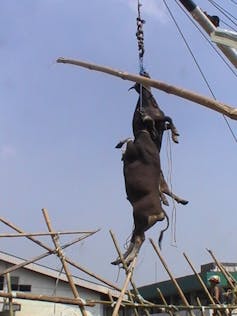Kevin Rudd advocated a return to a strong live cattle export trade between Australia and Indonesia at a business breakfast in Jakarta on Friday. Maybe he thought the Australian public wouldn’t notice.
Australians gave the trade with Indonesia a resounding thumbs down after videos were released showing cattle being cruelly slaughtered in local abattoirs.
The Prime Minister avoided using the words “live” and “export”, but simply referred to Indonesia having “some of the very best intensive feedlots in the world” and Australia having “extensive grazing lands and traditions of pastoral excellence”.
Mr Rudd focused his talk on the ever-increasing growth in the Indonesian economy, which will in future dwarf Australia’s home market for beef. “Indonesia should become a vast market place for Australian goods”, he said. He foretold of an Indonesian middle class of 135 million by 2030 and of Australia and Indonesia taking on the world’s beef markets together.
At the same time Mr Rudd promised A$60 million to grow Indonesia’s own beef industry. This will probably go to feedlots that will fatten cattle exported from northern Australia. The only way Indonesia could produce enough feed to fatten Australian cattle is to convert native rainforest into cultivable land, threatening soils, carbon stocks and critically endangered animals like orang-utan.
Slaughter in Indonesia
If Kevin Rudd is to rescue the northern beef industry from its current plight he must focus on a carcass trade, because neither of the two problems in the live trade to Indonesia – slaughter methods and the shipping process – can be easily solved.
The reality of slaughter in Indonesia is far from what the Australian public consider acceptable. The slaughter of Australian cattle is done by members of the poorer classes under third world conditions.
Slaughter methods are subject to religious and political constraints that are difficult to solve right now. Some Muslim Indonesians see any attempt to impose stunning of the cattle before slaughter as an infringement of their religious freedom.
In the Hadith,the supplement to the Koran, cattle are required to die by a knife cut to the throat. Done well, this kills after 15-20 painful seconds in the majority of animals, longer in some. Done badly and the animal will suffer a slow and agonizing death. Stunning is still controversial and most methods of stunning would potentially cause irreversible damage to some animals.
Slaughter guidelines developed by the World Animal Health Organisation have been adopted by the Australian government to underpin its standards since 2011. Whilst it is good that Australia is seeking to gain support for international standards, the guidelines utilised are not rigorous enough for the Australian public.
Last year Australia introduced the Export Supply Chain Assurance Scheme to verify that OIE standards are abided by. Some other major destinations for our livestock, such as Saudi Arabia, have not yet accepted the scheme and may never do so.
Any attempt to impose overseas standards for slaughter and monitoring systems is likely to be seen as an attack on Indonesian liberty and values. Mr Rudd touted free trade as the objective of the renewed collaboration with Indonesia. But Australia is imposing its standards on Indonesian slaughter practices through the supply chain scheme.
Live export
The live export process itself is inherently damaging to the welfare of the animals. The high stocking density, required for economic transport of the animals, results in rapid accumulation of ammonia, which irritates the animals’ (and the crew’s) throat, nose and eyes. An inflammation establishes itself in the lungs and the eyes of sheep become encrusted with conjunctivitis. Increasing the ventilation rate is one possibility, but already the vessels have difficulty achieving enough air movement, which they do with noisy, high powered fans that are likely to stress the animals.

Within Indonesia cattle are often shipped between islands. Loading onto ships may be done by roping their heads together and hoisting the rope (with bodies dangling) aboard using a small crane. Offloading may even occasionally consist of forcing the cattle off the ship with no option but to swim ashore.
Focus on carcass trade
Indonesia’s growing prosperity will ensure that the middle class households emerging will have refrigerators, no longer requiring them to buy meat daily in the “wet” markets. A strong carcass trade may yet emerge as the solution to the woes of Australia’s cattle trade.
Meanwhile low meat prices caused by the reduced overseas market, in particular in Indonesia, are discouraging Australian producers from buying animal feed to avoid cattle dying in the current wintry weather in Victoria, as they did in drought-ridden northern Queensland earlier in the year. Producers have a moral responsibility to act in such emergencies, but in desperate times this may favour the bullet rather than the feed option.
As Mr Rudd works to end the boat trade bringing asylum seekers to Australia, he would do well to remember that the boats taking cattle from Australia also need his urgent attention.

